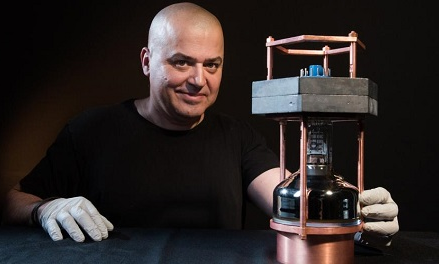In 1974, a Fermilab physicist predicted a new way for ghostly particles called neutrinos to interact with matter. More than four decades later, a University of Chicago (UChicago)-led team of physicists built the world’s smallest neutrino detector to observe the elusive interaction for the first time.
Washington (ISJ) – In 1974, a Fermilab physicist predicted a new way for ghostly particles called neutrinos to interact with matter. More than four decades later, a University of Chicago (UChicago)-led team of physicists built the world’s smallest neutrino detector to observe the elusive interaction for the first time.
Neutrinos are a challenge to study because their interactions with matter are so rare. Particularly elusive has been what’s known as coherent elastic neutrino-nucleus scattering, which occurs when a neutrino bumps off the nucleus of an atom.
The international COHERENT Collaboration, which includes physicists at UChicago, noticed the scattering process by using a detector that’s small and lightweight enough for a researcher to carry. Their findings, which confirm the theory of Fermilab’s Daniel Freedman, were reported in the latest edition of the journal Science.
“Why did it take 43 years to observe this interaction?” asked co-author Juan Collar, UChicago professor in physics. “What takes place is very subtle.” Freedman did not see much of a chance for experimental confirmation, writing at the time: “Our suggestion may be an act of hubris, because the inevitable constraints of interaction rate, resolution and background pose grave experimental difficulties.”
When a neutrino bumps into the nucleus of an atom, it creates a tiny, barely measurable recoil. Making a detector out of heavy elements such as iodine, cesium or xenon dramatically increases the probability for this new mode of neutrino interaction, compared to other processes. But there’s a trade-off, since the tiny nuclear recoils that result become more difficult to detect as the nucleus grows heavier.
“Imagine your neutrinos are ping-pong balls striking a bowling ball. They are going to impart only a tiny extra momentum to this bowling ball,” Collar said.
To detect that bit of tiny recoil, Collar and colleagues figured out that a cesium iodide crystal doped with sodium was the perfect material. The discovery led the scientists to jettison the heavy, gigantic detectors common in neutrino research for one similar in size to a toaster.
The 4-inch-by-13-inch detector used to produce the Science results weighs only 32 pounds (14.5 kilograms). In comparison, the world’s most famous neutrino observatories are equipped with thousands of tons of detector material.
“You don’t have to build a gigantic laboratory around it,” said UChicago doctoral student Bjorn Scholz, whose thesis will contain the result reported in the Science paper. “We can now think about building other small detectors that can then be used, for example to monitor the neutrino flux in nuclear power plants. You just put a nice little detector on the outside, and you can measure it in situ.”
Neutrino physicists, meanwhile, are interested in using the technology to better understand the properties of the mysterious particle.
“Neutrinos are one of the most mysterious particles,” Collar said. “We ignore many things about them. We know they have mass, but we don’t know exactly how much.”
Through measuring coherent elastic neutrino-nucleus scattering, physicists hope to answer such questions. The COHERENT Collaboration’s Science paper, for example, imposes limits on new types of neutrino-quark interactions that have been proposed.
The results also have implications in the search for Weakly Interacting Massive Particles. WIMPs are candidate particles for dark matter, which is invisible material of unknown composition that accounts for 85 percent of the mass of the universe.
“What we have observed with neutrinos is the same process expected to be at play in all the WIMP detectors we have been building,” Collar said.


